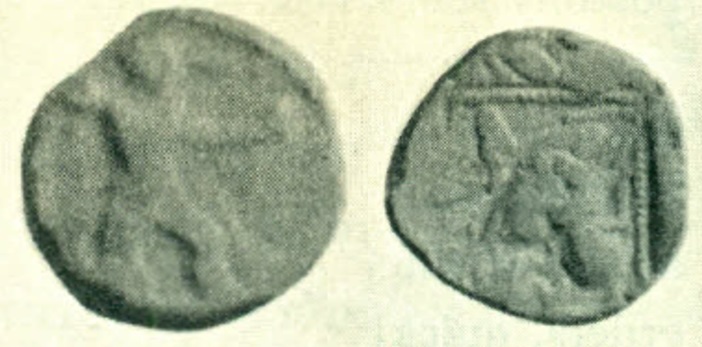449 BCE - 425 BCE | L'Z'B'L (in Aramaic)
Overstriking coin
Citium_over_Athens_Oxford,_AM.jpg
Overstruck variety
Athens under Citium.jpg
[1]
Description
| ObverseInscription or printing placed on the obverse.:
|
Herakles in fighting stance to right, wearing lion skin upon his back and tied around neck, holding club overhead in right hand and bow extended before him in left hand. Dotted border.
|
ReverseInscription or printing placed on the reverse.:
|
L'Z'B'L (in Aramaic) (Aramaic) Lion attacking stag crouching right inside dotted border within incuse square.
|
Mint and issuing power
Chronology
| FromIdentifies the initial date in a range assigned in a numismatic context. 449 BCE toIdentifies the final date in a range assigned in a numismatic context.. 425 BCE
|
Classical 480-323 BC  periodTime period of the numismatic object. periodTime period of the numismatic object.
|
Physical description
MetalThe physical material (usually metal) from which an object is made.: Silver 
|
WeightWeight of the numismatic object (in grams). in grams: 10.8810.88 g <br />10,880 mg <br />
|
DenominationTerm indicating the value of a numismatic object. Examples: tetradrachm, chalkous, denarius.: double siglos 
|
|
|
|
StandardStandard.: Persian
|
References
| Coin referenceReference of the Coin:
|
Milne, "Overstruck Cypriote Staters", The Numismatic Chronicle 5/1 (1945), p. 78-79, no. 2.
|
Coin series referenceReference to coin series study:
|
BMC Crete1BMC Crete, p. 10-11, n° 16-18, pl. III, n° 1-4, Tziambazis 20022Tziambazis 2002, n° 17, Zapiti - Michaelidou 20083Zapiti - Michaelidou 2008, n° 5, Milne 19454Milne 1945, p. 78-79, n° 2
|
| Coin series web referenceCoin series web references:
|
|
Description
| ObverseInscription or printing placed on the obverse.:
|
Helmeted head of Athena right, with frontal eye
|
ReverseInscription or printing placed on the reverse.:
|
AΘE (Greek) Owl standing right, head facing, closed tail feathers, olive spray and crescent to left, all within incuse square
|
Mint and issuing power
| MintIdentifies the place of manufacture or issue of a numismatic object. ᵖ:
|
Athens
|
Ancient regionAncient region. ᵖ
|
Attica
|
Modern countryModern country: Greece
|
AuthorityIdentifies the authority in whose name (explicitly or implicitly) a numismatic object was issued. ᵖ:
|
|
Chronology
| FromIdentifies the initial date in a range assigned in a numismatic context. 454 BCE toIdentifies the final date in a range assigned in a numismatic context.. 404 BCE
|
Classical 480-323 BC  periodTime period of the numismatic object. periodTime period of the numismatic object.
|
Physical description
| DenominationTerm indicating the value of a numismatic object. Examples: tetradrachm, chalkous, denarius. ᵖ:
|
tetradrachm 
|
StandardStandard. ᵖ:
|
Attic
|
References
References
- ^ Wroth, Warwick William (1886), A Catalogue of the Greek coins in the British Museum. vol. X : Crete and the Aegean Islands, London, The Trustees, p. 152, pl. XXIX
- ^ Tziambazis, Elias (2002), A catalogue of the coins of Cyprus: from 560 B.C. to 1571 A.D., Larnaca, 89 p.
- ^ Zapiti, Eleni - Michaelidou, Lefki (2008), Coins of Cyprus : from the collection of the Bank of Cyprus Cultural Foundation, Nicosia, Bank of Cyprus Cultural Foundation, 329 p.
- ^ Milne, Joseph Grafton (1945), "Overstruck Cypriote staters", Numismatic Chronicle 6 (5), p. 78-79.
- ^ Hoover, Oliver D. (2014), Handbook of Greek Coinage Series 4. Northern and Central Greece : Achaia Phthiotis, Ainis, Magnesia, Malis, Oita, Perrhaibia, Thessaly, Akarnania, Aitolia, Lokris, Phokis, Boiotia, Euboia, Attica, Megaris and Corinthia, sixth to first centuries BC, Lancaster, lxxi, 563 p.


